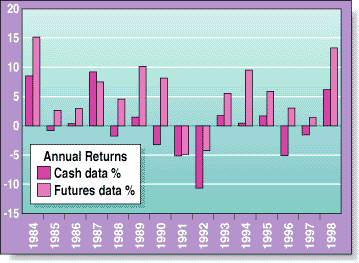MANAGED FUTURES
Inherent Return In Futures Markets
by Charles R. Lightner
In the March 1999 STOCKS & COMMODITIES, I argued for the existence of an inherent return to the noncommercial investor in the futures markets. The essence of my argument was sevenfold: one, that the futures markets exist in order to allow those with commercial interests in the goods traded to protect themselves against unwanted price risk. Two, that the commercial interests are of two types -- producers of the goods traded (such as farmers or miners) and primary consumers of the goods traded (such as cerealmakers or jewelers). Three, that the hedging desires of the commercial interests are rarely in balance and the outside investor is required to provide the balance the hedging community needs. Four, that the outside investor provides the liquidity the futures markets need and accepts the risk that the hedgers want to avoid. Five, that the outside investors will not provide those services for any substantial length of time without being adequately compensated. Six, that compensation to the investors as a group can only come from profits made in futures market trading and those profits can only come from the hedger group. And seven, that this compensation is, in essence, an "implicit fee" flowing to the outside investor community from the hedging community in exchange for the services provided. This implicit fee represents the inherent return that the futures markets, as a whole, must produce to compensate the function performed by the outside investor group.

FIGURE 1: ANNUAL RETURNS. Here are the annual returns for the cash data and the MLM Index over the test period of 1984 to 1998.COMMERCIAL DEMAND
I suggested that the Commitment of Traders data published by the Commodity Futures Trading Commission (CFTC) supported the idea that noncommercial investors in the futures markets adopt a trend-following approach. The hedging desires of the producers and those of the primary consumers are not symmetrical. When prices trend higher, the producers will have more of an incentive to sell but the primary consumers will have less of an incentive to buy, and vice versa. So the need for the outside investor will increase as the strength of price movement increases.
This argument is supported by the characteristics of the investor community. Most of the outside investors' funds are arranged in some sort of trend-following approach.
Charles R. Lightner is president of Affiliated Investment Strategies, 423 North Avenue West, Westfield, NJ 07090, 908 654-8768, E-mail crl-ais@home.com.
Excerpted from an article originally published in the July 1999 issue of Technical Analysis of STOCKS & COMMODITIES magazine. All rights reserved. © Copyright 1999, Technical Analysis, Inc.
Return to July 1999 Contents